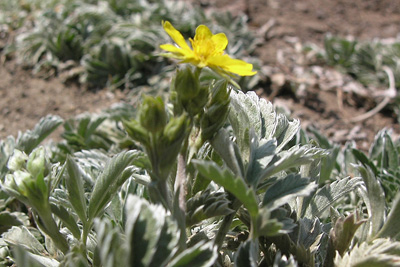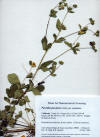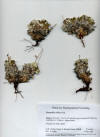|
Drymocallis (Potentilla) glandulosa
|
Drymocallis glandulosa Idaho: North-central, Clearwater Natl. For., Eldorado Creek near jct. with Dollar Creek, 46º17.964, 115º38.776, elev. 3,540 ft, wetland prairie with dominant Veratrum californicum surrounded by forest of Englemann spruce, subalpine fir, western red cedar, lodgepole pine, western larch. 26 July 2011 |
Drymocallis lactea var. lactea
California. Kern Plateau, Tulare Co.,
Taylor Creek
|
|
|
Potentilla egedii ssp.
grandis
|
Potentilla gracilis var. fastigiata Kern Plateau, Tulare Co.,
CA, Horse Campground |
 |
Potentilla
hippiana |
|
Potentilla multifida
|
Alaska:
Potentilla villosa
|
| Potentilla anserina | |
|
Li PL, Lin CJ, Zhang ZX, Jia ZJ. 2007. Three new triterpenoids from Potentilla multicaulis. Chem Biodivers. 4(1):17–24. “Three new triterpenoids, 19-hydroxy-2,3-secours-12-ene-2,3,28-trioic acid 3- methyl ester (1), 19-hydroxy-1-oxo-2-nor-2,3-secours-12-ene-3,28-dioic acid (2), and (3beta,18alpha,19alpha)-3,28-dihydroxy-20,28-epoxyursan-24-oic acid (3), were isolated from the roots of Potentilla multicaulis. Their structures were elucidated on the basis of spectroscopic methods (IR, HR-ESI-MS, and 1D- and 2D-NMR). Compound 2b exhibited moderate cytotoxic activity against human promyelocytic leukemia (HL-60) cells.” Liu P., H. Q. Duan, Q. Pan, Y.W. Zhang and Z. Yao. 2006. [Triterpenes from herb of Potentilla chinesis] Zhongguo Zhong Yao Za Zhi. 2006 Nov;31(22):1875-9. [In Chinese]. “OBJECTIVE: To study the chemical constituents of Potentilla chinesis and their anticancer activities. METHOD: Chemical constituents were isolated by repeated column chromatography (Toyopearl HW-40C and preparative HPLC). The structures were elucidated on the basis of spectral data analysis. The isolated compounds were screened with two anticancer models. RESULT: Fifteen triterpenes, alpha-amyrin (1) , beta-amyrin (2) , ursolic acid (3) , corosolic acid (4), euscaphic acid (5) , pomolic acid (6) , tormentic acid (7), 2alpha, 3alpha-dihydroxyurs-12-en-28-oic acid (8), 2beta, 3beta, 19alpha-trihydroxyurs-12-en-28-oic acid (9), asiatic acid (10) , 24-hydroxy tormentic acid (11) , myrianthic acid (12), oleanolic acid (13), maslinic acid (14) and 2alpha, 3alpha-dihydroxyolean-12-en-28-oic acid (15) , were isolated from P. chinesis. CONCLUSION: Compounds 1, 2, 4 -15 were isolated from the plant for the first time. Compounds 4, 8 - 10, 12, 14 and 15 show anticancer activities. Compounds 4, 9 show strong activities.” Spiridonov N. A., D. A. Konovalov and V. V Arkhipov. 2005. Cytotoxicity of some Russian ethnomedicinal plants and plant compounds. Phytother. Res. 19(5): 428–432. “The cytotoxic action of crude ethanol extracts from 61 plant species used in Russian ethnomedicine for alleviating symptoms of diseases in cancer patients was studied on cultured human lymphoblastoid Raji cells. Extracts from Chelidonium majus, Potentilla erecta, Chamaenerium angustfolium, Filipendula ulmaria and Inula helenium possessed marked cytotoxicity, suppressing the growth of the cells at concentrations of 10 and 50 microg/mL. The cytotoxicity of purified active compounds from selected plant species was evaluated along with pharmaceutical antineoplastic drugs methotrexate, fluorouracil, cyclophosphamide and vinblastine. Sesquiterpene lactones helenin, telekin and artemisinin, aromatic polyacetylene capillin, and alkaloid preparation sanguirythrine suppressed cell growth at concentrations of 1-2 microg/mL, which exceeds the cytotoxicity of cyclophosphamide and fluorouracil.”
|
|







